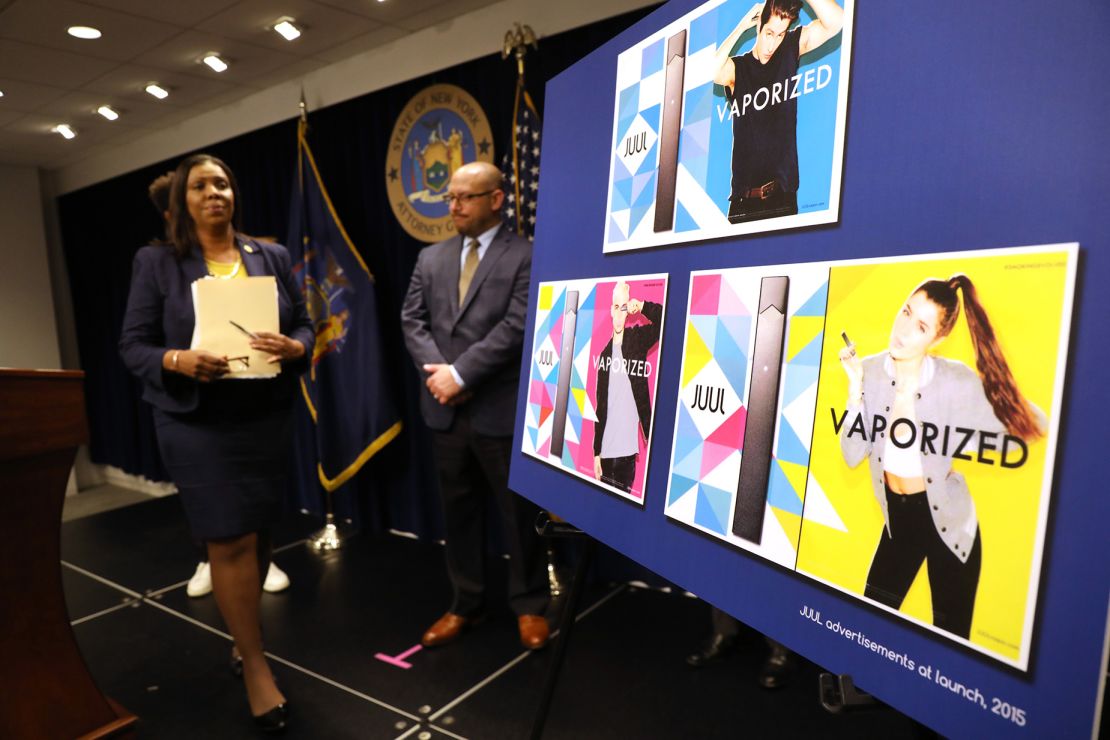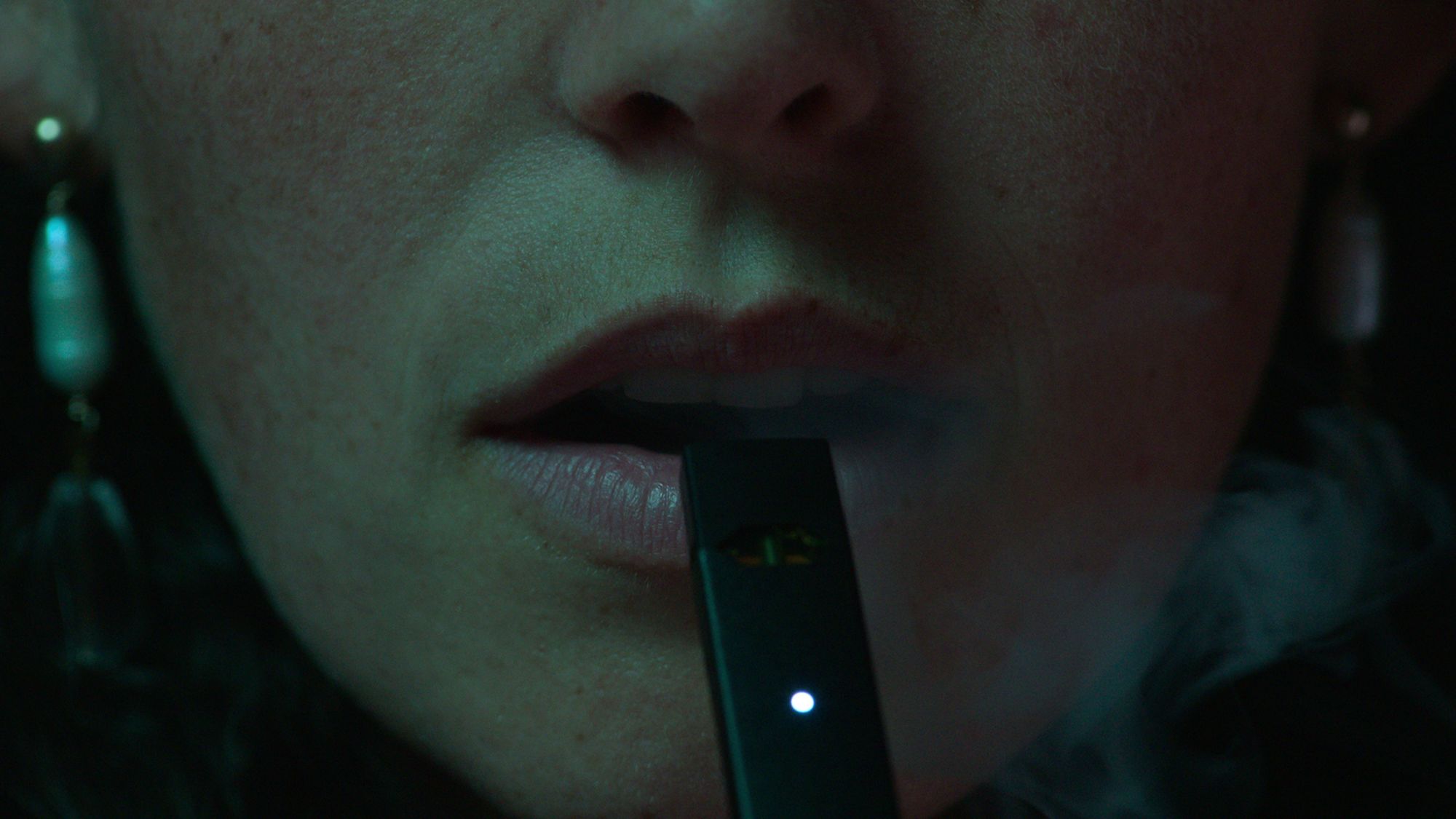Editor’s Note: Keeping you in the know, Culture Queue is an ongoing series of recommendations for timely books to read, films to watch and podcasts and music to listen to.
As Juul’s popularity began to surge in 2016, the sleek USB-shaped e-cigarette was seemingly everywhere overnight, with clouds of vapor and the audible crackle of a deep pull.
If you were a millennial, brought up amid secondhand smoke in homes and restaurants in the ’80s and ’90s (like this writer), Juul’s rise might not have felt so alarming. After all, many longtime smokers were tossing out their cigarettes in exchange for vapes after years or decades of attempts to quit — though, yes, they may have ended up more addicted to their new pocket companions, which claimed to carry fewer health risks than combustible tobacco but packed a big punch of nicotine and could be puffed all day.
But if you were a teenager, Juul’s impact was immediately striking — and likely unnerving for your parents — as explored in a new Netflix docuseries. Directed by R.J. Cutler, “Big Vape: The Rise and Fall of Juul” charts how enticing product design, potent influencer marketing and dubious corporate decision-making saw the product’s popularity soar among underage users, too, before the eventual crash of its parent company, Juul Labs. Once one of the fastest-growing startups in the US (valued at $38 billion at its peak), the company has now lost 95% of its value, and has settled $3 billion in lawsuits over its marketing tactics in the US. Nearly all of its flavors have been pulled from the market and the device itself was temporarily banned by the Food and Drug Administration — though that decision is now under review.
What made Juul so desirable? Eight years after its launch, the docuseries sets out to answer that question, positing that founders James Monsees and Adam Bowen made a grave error of judgment in treating nicotine as an issue that could be solved by tech, rather than public health initiatives. Early on, the Juul was called “the iPhone of e-cigs” in a Wired review by reporter David Pierce — an association that stuck, given its simple design and magnetic appeal.
How Juul Labs was led astray from its original mission — to make cigarettes obsolete — isn’t cut and dry, though Pierce said of the company in “Big Vape” that, “Their goal was not to make people quit smoking; their goal was to make people start Juuling.”
Murky motives
Juul’s splashy, aspirational launch campaign promoted the device as a must-have for twenty-somethings, and echoed classic (and long banned) cigarette campaigns, as “Big Vape” points out.
“James and Adam really wanted Juul to be seen as a luxurious, sophisticated product that people would not be embarrassed to use, unlike some vaping products which had been seen as dorky and uncool,” said Jamie Ducharme, author of the book that the docuseries was based on, in “Big Vape.”
But Juul’s “Vaporized” campaign, shown larger-than-life in Times Square and at pop-ups in cities across the US, seemed to fall flat at first. The e-cigarette could well have been sent to the graveyard of forgotten tech, were it not for word of mouth and, according to “Big Vape,” celebrity use — Bella Hadid, Dave Chapelle, Adele and Jennifer Lawrence are all namedropped in the docuseries — that sent Juul mainstream. For Gen Z, it catalyzed countless memes and hashtags, a new nicotine-fueled social ritual in and out of school, and quite possibly for many, a lifelong habit.
“Juul definitely did create a newfound sense of unification for the generation that I grew up in,” Chase Amiratta, who began using Juul as a teenager, said in the docuseries.

“Over the past years, Juul Labs has committed to resetting its relationship with our stakeholders and re-earning trust,” a company spokesperson said in a statement emailed to CNN when asked for comment on the docuseries, noting that underage use (that is, by people aged under 21) of Juul products “has dropped by 95%.”
“To the extent that this documentary captures that journey, we hope it can help advance a more balanced public dialogue about the opportunity for tobacco harm reduction through effective alternatives like Juul products… ” the spokesperson continued.
“Big Vape” neither neatly ties up Juul’s troubles nor addresses the company’s motives. Though a handful of former Juul employees and board members participated in the documentary, it remains unclear how much of its multi-billion-dollar blunder was profit-driven or out of ignorance to the fact that Juul’s appeal among adults, including its flavors, would draw in minors, too.
“I literally had people tell me, ‘There’s no way that adults like mango as much as kids do,’” said Erica Halverson, a former marketing manager at Juul, of the bestselling flavor. “That’s a bunch of bulls***t to me. Bulls***t.”
“Big Vape: The Rise and Fall of Juul” is out now on Netflix.
Add to Queue: Big tech, big fails, big vices
Read: “Big Vape: The Incendiary Rise of Juul” by Jamie Ducharme (2021)
Time journalist Jamie Ducharme’s book, which investigates how two Stanford grads’ well-intentioned thesis project became the Juul we know today — served as source material for the Netflix documentary.
Watch: “WeWork: or The Making and Breaking of a $47 Billion Unicorn” (2021)
What happened to WeWork? The ubiquitous co-working company seemed to be riding high before it all spectacularly fell apart. This documentary examines how all the red flags, from reckless spending to the founders’ potential conflicts of interest, looked from the outside.
Watch: “Thank You for Smoking” (2005)
This Jason Reitman-directed black comedy follows Big Tobacco lobbyist Nick Naylor (Aaron Eckhart), who spins, spins, spins the narrative by any means necessary, his job at odds with his role as parent to a 12-year-old.
Listen: “From Sock Puppet to Flop: The story of Pets.com” (2020)
Pets.com was a marketer’s dream in 1999, with an instantly recognizable sock puppet mascot who made appearances in Superbowl ads and the Macy’s Thanksgiving Day Parade. But beneath its multimillion-dollar advertising budget were smoke and mirrors. This podcast episode does a deep dive into one of the most notorious dotcom-era fails.
Read: “Dopamine Nation” by Anna Lembke, MD (2023)
We’re living in an age of access to constant pleasure hits, from traditional vices to our always-on phones and feeds, argues neuroscientist Dr. Anna Lembke, whose new book explains how to strike a deal with the reward-seeking parts of our brain for a more balanced life.

